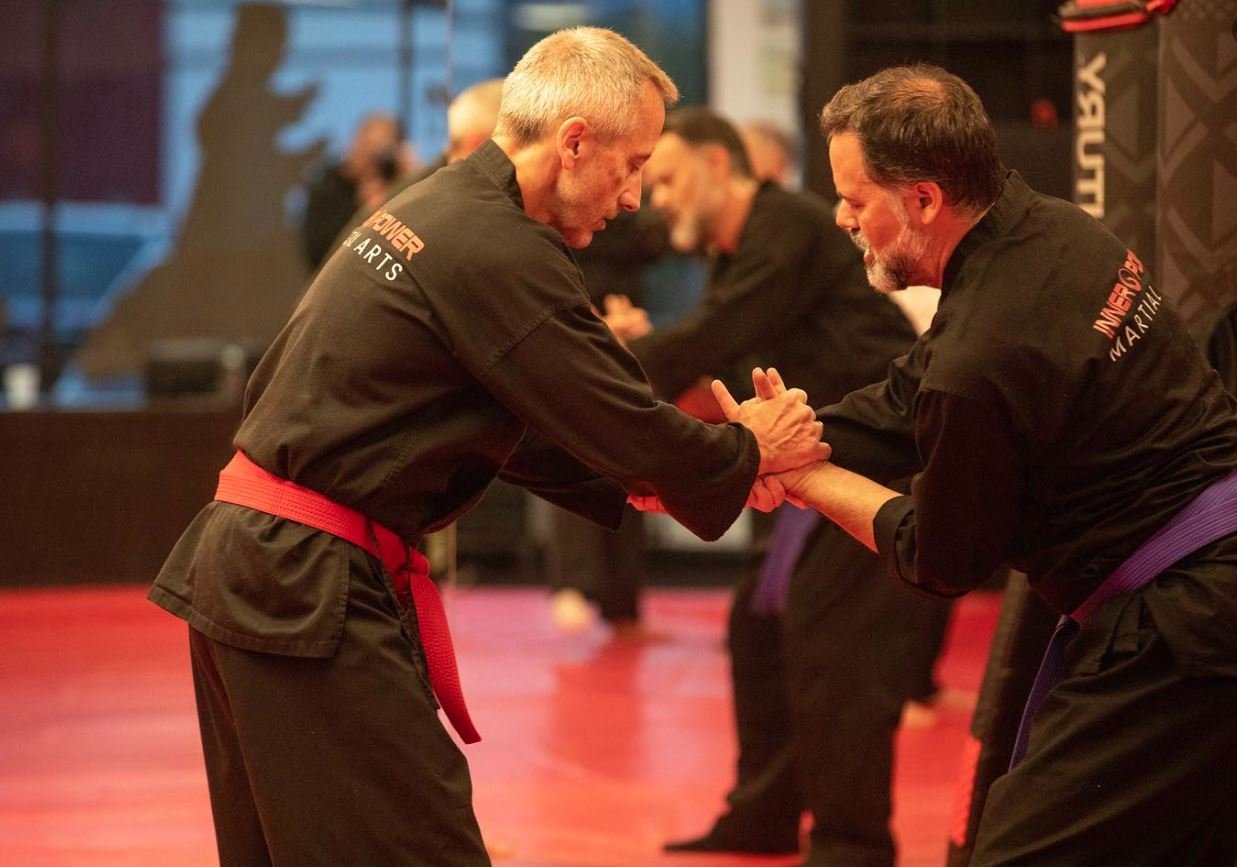How Many Belts Are There Between White Belt and Black Belt in Hapkido?
One of the questions I often get as a Hapkido school owner is, “How many belts are there between white belt and black belt in Hapkido?” That’s a great question! We all have goals, and in martial arts, that black belt is often seen as a major milestone — a symbol of dedication, hard work, and transformation. Who wouldn’t want to know how long it might take to achieve that goal?
Get Started Now >
Different Martial Arts Styles Have Different Belts
When you begin your martial arts journey, you’ll quickly notice that each style has its own approach to belt progression. Karate, taekwondo, kung fu, judo, and jujitsu all have unique systems with varying belt colors and requirements. Just about every martial art begins with a white belt for beginners. From there, the colors and number of belts can vary widely depending on the style and school.
Some systems have as few as five belts, while others include ten or more before reaching black belt. That’s why it’s always a good idea to check with your specific instructor or school. At our Hapkido school in Howell, New Jersey (Monmouth County), we follow the Jung Ki Kwan system, which provides a structured and authentic path from white belt to black belt and beyond.
Hapkido White Belt in Howell, New Jersey
White belt is where it all begins. It signifies a pure beginning, an open mind, and the willingness to learn something new. I’ve always felt that the white belt is one of the most important ranks in all of martial arts. It shows tremendous courage to step onto the mat for the first time. Walking into a martial arts school, especially if you’ve never trained before, can feel intimidating. You might wonder if you’re in good enough shape, if you’re too old or too young, or if you’ll be able to keep up.
At our school here in Howell, we make it a priority to be extremely beginner-friendly for both kids and adults. We strive to create a warm, welcoming atmosphere where you’re not judged by your experience level, your fitness, or your background. Whether you’ve trained in other martial arts or are stepping on the mat for the very first time, we’re here to support you every step of the way.
Jung Ki Kwan Hapkido
In Hapkido, there are many “Kwans” or schools, each with its own focus and training methods. We follow the Jung Ki Kwan Hapkido syllabus, which is one of the most traditional and complete versions of Hapkido, rooted in the teachings of its founder, Choi Young Sul. What makes Jung Ki Kwan special is its focus on preserving the original spirit and techniques of Hapkido.
More important than the number of belts is what you learn along the way. Between white and black belt, students learn approximately 110 self-defense techniques. These include powerful and practical skills such as joint locks, throws, strikes, pressure point techniques, and off-balancing moves. These foundational movements are essential, as they become the building blocks for more advanced skills after black belt.
How Long Will It Take to Earn a Black Belt?
One of the most common follow-up questions I hear is: “How long does it take to earn a black belt in Hapkido?” That answer depends on a few factors. Progress is influenced by a student’s dedication, natural ability, consistency in training, and willingness to learn.
At our Monmouth County martial arts school, we’ve seen students earn their black belts in as little as three years. Others may take five, six, or even seven years. And that’s perfectly okay! Everyone has their own pace, and martial arts is not a race. It’s a journey of self-improvement. The key is to stay consistent and enjoy the process. The physical, mental, and emotional benefits are incredible — improved fitness, confidence, discipline, and stress relief, just to name a few.
The Jung Ki Kwan Hapkido Belt System
Let’s take a closer look at the typical belt progression in Jung Ki Kwan Hapkido. The color belts, also known as Gup ranks or foundational levels, are:
-
White Belt
-
Yellow Belt
-
Blue Belt
-
Red Belt
-
Purple Belt
Once a student reaches the black belt, they enter the Dan ranks, which are considered advanced levels. While it may seem like the black belt is the “end goal,” in reality, it’s just the beginning of a deeper understanding of martial arts.
Contrary to popular belief (thanks to Hollywood movies and TV shows), a first-degree black belt is not a sign of complete mastery. In Hapkido, it means that you’ve learned the fundamentals and now have the foundation to move on to more advanced techniques and concepts.
What Do the Stripes Mean on Hapkido Belts?
In our system, we use stripes to indicate progress both within the color belt ranks and at the black belt level.
-
On color belts, stripes represent progress within the curriculum. Students usually need to earn four stripes before becoming eligible to test for the next rank.
-
On black belts, stripes (or bars) indicate Dan rank. For example, a black belt with two stripes is a 2nd-degree black belt.
This structured approach helps students see measurable progress and stay motivated as they continue to grow in skill and understanding.
The Black Belt Ranking System
After earning a first-degree black belt, students may continue their training and advance through higher Dan ranks. Each level requires additional knowledge, time, and dedication:
-
1st Dan – Beginning of advanced training
-
2nd Dan
-
3rd Dan
-
4th Dan – Master level begins here
-
5th Dan
-
6th Dan
-
7th Dan – Grandmaster level begins here
-
8th Dan
The 9th Dan is a rare and prestigious rank, typically reserved for lifelong practitioners and leaders in the art. Our lineage traces back to Grandmaster Lim, Hyun Su, the founder of Jung Ki Kwan, who is one of only three people ever awarded the 9th Dan by Hapkido’s founder, Choi Young Sul. Grandmaster Lim continues to teach and promote traditional Hapkido around the world.
The 10th Dan rank is reserved posthumously for Choi Young Sul (1904–1986), the founder of Hapkido.
Training with Grandmaster Lim, Hyun Su
In 2011, I had the incredible honor of training with Grandmaster Lim alongside several of our students. It was a powerful experience to connect directly with someone so close to the origins of Hapkido. These moments are a reminder of how deep and meaningful this martial art is. It’s not just about techniques — it’s about tradition, respect, discipline, and constant personal growth.
Interested in Earning Your Own Hapkido Belts?
If you’re curious about starting your own Hapkido journey and working toward your own black belt, we’d love to help you get started. Whether you’re a complete beginner or have trained before, we offer programs for kids, teens, and adults that focus on self-defense, physical fitness, and personal growth.
📞 Call 732-886-5556
📧 Contact Us Now
Start your journey today and discover how martial arts can transform your life!
Frequently Asked Questions
Q: Is Hapkido part of Korean martial arts?
A: Yes, Hapkido is one of the core Korean martial arts. Alongside Taekwondo and Kuk Sool Won, it’s considered one of the “big three.” What makes Hapkido unique is its blend of techniques — it borrows from traditional jujitsu, aikido, and even some striking methods found in kung fu and karate. It’s known for its dynamic self-defense approach, using an opponent’s energy and momentum against them.
Q: Is there a green belt in Hapkido martial arts training?
A: Some schools may include a green belt depending on their specific curriculum, but in our Jung Ki Kwan system, we do not have a green belt in the standard progression. Instead, we use yellow, blue, red, and purple between white and black. However, curriculum stripes on belts can often look like green or include green elements depending on the patch or school, which sometimes causes confusion.
Q: Why is there no brown belt in Hapkido?
A: In our system, brown belt is not part of the rank structure. Belt colors are chosen to represent stages of growth, much like seasons or natural elements. Each school or Kwan might have slight variations, but in Jung Ki Kwan Hapkido, we’ve found our color progression aligns well with the development of skill, knowledge, and maturity in students








